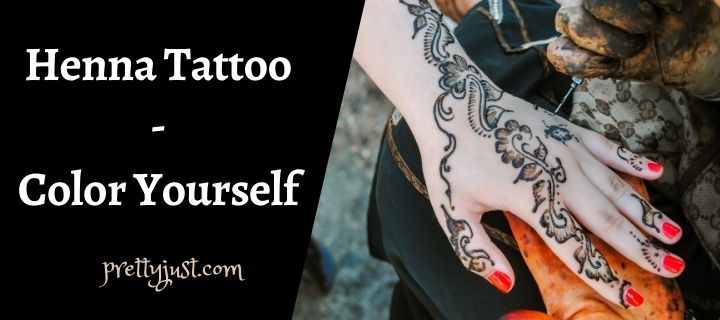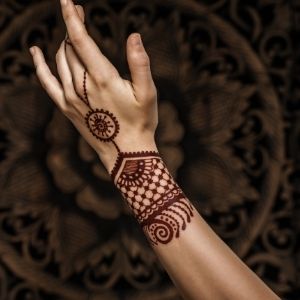The tattoo industry is fast growing in recent years with new innovations and improvement of this unique ancient art. Different cultures and countries have embraced different tattoo styles, which mostly represent something they value.
Every tattoo drawn on the skin is more than just ink. They come with deeper meaning like memories, people loved, and therapy or just a way of style.
Permanent tattoos come with a lot of pain and a strict aftercare routine that not all of us can stand. That is why there are temporary body art forms like henna which are painless and can be drawn and easily erased.
Here is a complete guide on henna tattoos.
What is Henna Tattoo?

A henna tattoo is a temporary body art that gradually fades away after a few days. It is made out of ink from a henna plant, which grows mostly in Africa, Arab and Asian countries.
Dry henna leaves are crushed to make a powder which is mixed with water or lemon juice to form a dark brown paste. The paste is left to settle for 48 hours, after which it is applied to the skin, leaving a reddish-brown color.
These days, henna is sold in powder form, ready to be mixed into a paste.
Henna is drawn like a typical tattoo, just that it is not painful at all and is temporary tattoo. The most exciting part with henna is that you can draw the art yourself on your body using available items like a toothpick, a small piece of stick or a small brush, among other things.
Origin of Henna
 Henna is believed to originate from the Middle East, North Africa, and India close to 5000 years ago. Most of these countries applied this special body art to honor religious holidays.
Henna is believed to originate from the Middle East, North Africa, and India close to 5000 years ago. Most of these countries applied this special body art to honor religious holidays.
It is an essential part of most Asian celebrations like weddings and Diwali. Apart from body arts, women also used it to dye their hair color. In some countries like Morocco, this kind of art is used to appease the Djinn (evil spirits), while most Muslim countries believe it keeps away evil eyes.
Nowadays, many people apply henna to the body for many reasons and not just religious ones. In some events, attendees draw henna arts to represent the main theme. Some people go for henna since they just want a temporary option for a permanent tat.
How is a Henna Tattoo Drawn?
Unlike a permanent tattoo which is painful, a henna tattoo application is therapeutic and very relaxing. The artist draws the design with a freehand, which takes about 30 minutes for a simple design and few hours for intricate designs.
The paste is then left on the skin to dry before it is wiped off after it begins flaking. The longer you leave it on the skin, for instance, 24 hours and more, the darker it appears and the longer it lasts. Some people often apply a blend of sugar and lemon juice to the paste to intensify the dye. This is optional, but you must leave it on the skin for a long time for better results.
Common Placements of Henna Tattoo
 Similar to other tattoos, you can draw henna on any body part of your choice. However, most people believe henna tats are more symbolic when placed on some parts of the body.
Similar to other tattoos, you can draw henna on any body part of your choice. However, most people believe henna tats are more symbolic when placed on some parts of the body.
For instance, if you apply it to your palms, you will attract blessings and good fortunes. You will also share these positive vibes with others.
If you choose to draw a henna body art on your top upper arms, it shows how much you’re protecting yourself. You can go for bigger sleeves and intricate designs which look cool and very cute.
Henna on your feet shows your openness to piousness. It merely indicates you value God (or gods), your morals and basic personal principles.
When it comes to designs, there are numerous designs you can choose from. They all have similar lines and patterns, making them look identical, yet each is unique in its nature. Common designs include floral patterns, vines, leaves, and peacocks.
Frequently Asked Questions
How long Does Henna Tattoo Last?
Henna tattoos can last anywhere between a week and three weeks, depending on how you care for them. Henna typically fades when the skin exfoliates itself. The more you expose the skin area to water, the faster it fades. To keep your henna tat vibrant for a longer time, you can apply beeswax or olive oil before you get into contact with water.
Why do People Fancy Henna Tattoos?
Well, apart from religious or cultural reasons, there’s a whole bunch of reasons why most people are going for henna tattoos. Apart from its beauty and simplicity, here are other reasons why this form of art is getting many people to join the bandwagon.
- Since henna occurs naturally in a plant, it is safe for the skin as it doesn’t contain harmful additions and allergens. Besides tattoos, it is also used as a natural hair colorant by most people around the world.
- It is temporary, requiring less commitment compared to permanent tats. You can effortlessly remove it when you want. Additionally, it does not require a strict aftercare routine.
- Easy to change. When drawing a tat, faults may occur, and it may not turn out how you wanted it. You know how hard and painful it can be to change or delete a tattoo you regret having. The best thing with henna is that you can easily change the design if you’re unhappy with it. Better still, you can effortlessly delete it.
- Less painful. Permanent tattoos use needles to insert ink into the dermis. This is contrary to henna which naturally seeps into the epidermis and smaller part of the inner skin layer. It makes it less painful and the best for people who have pain intolerance.
How Much Does it Cost to Get a Henna Tattoo?
Henna tattoos are cheaper to have compared to permanent tattoos. You can get a simple design for about $5, with the most expensive tattoos like full sleeves between $20 – &40.
While you can apply a henna tattoo on yourself at no cost, you should visit a professional henna tattooist for a larger and intricate piece. It might be expensive and could cost up to $60, but it is all worth it. If you don’t know an artist, then you can always find a vast collection of henna stencils on the internet.
How Do I Care For My New Henna Tattoo?
Although henna looks vibrant for about 14 days before it begins to fade, you can follow some simple instructions to make it look fresher and last longer, up to a month. Here is what you can do to maintain its color.
- Avoid exposing it to water by covering it when swimming or bathing.
- Keep off the area from salty water and harsh chemicals like chlorine.
- Similar to a permanent tattoo, keep it moisturized to counteract quick fading.
- After its application, avoid touching the paste and leave it to dry until it flakes off.
Conclusion
Henna tattoos are an innovative and beautiful alternative to a typical tattoo. It is a body art that has stayed relevant over a long time and is growing fast among other communities. Henna designs keep on evolving and representing different beliefs. This painless body art allows newbies to experiment whether they can commit to permanent body art.
Also read: What Does The Bible Say About Tattoos

